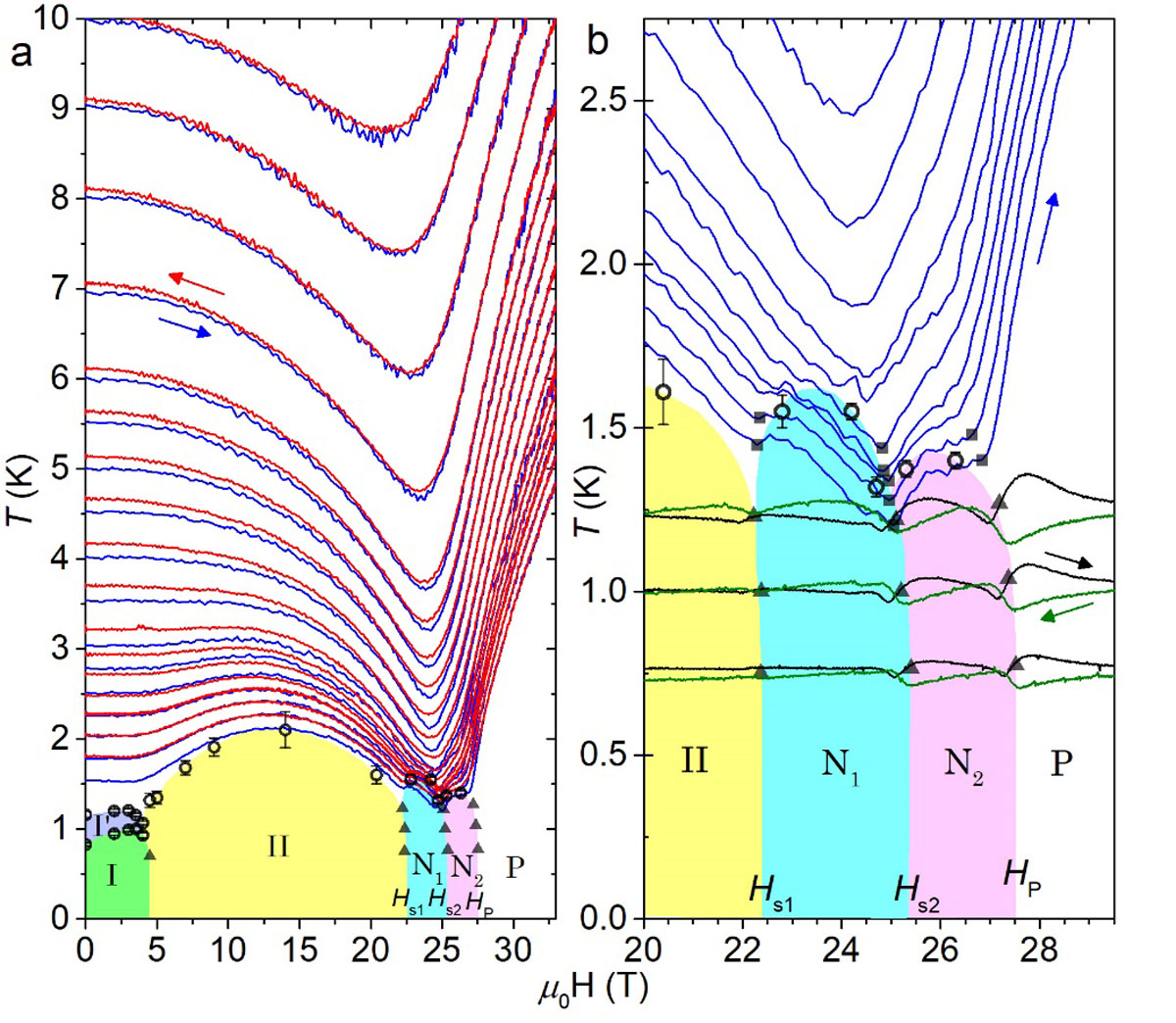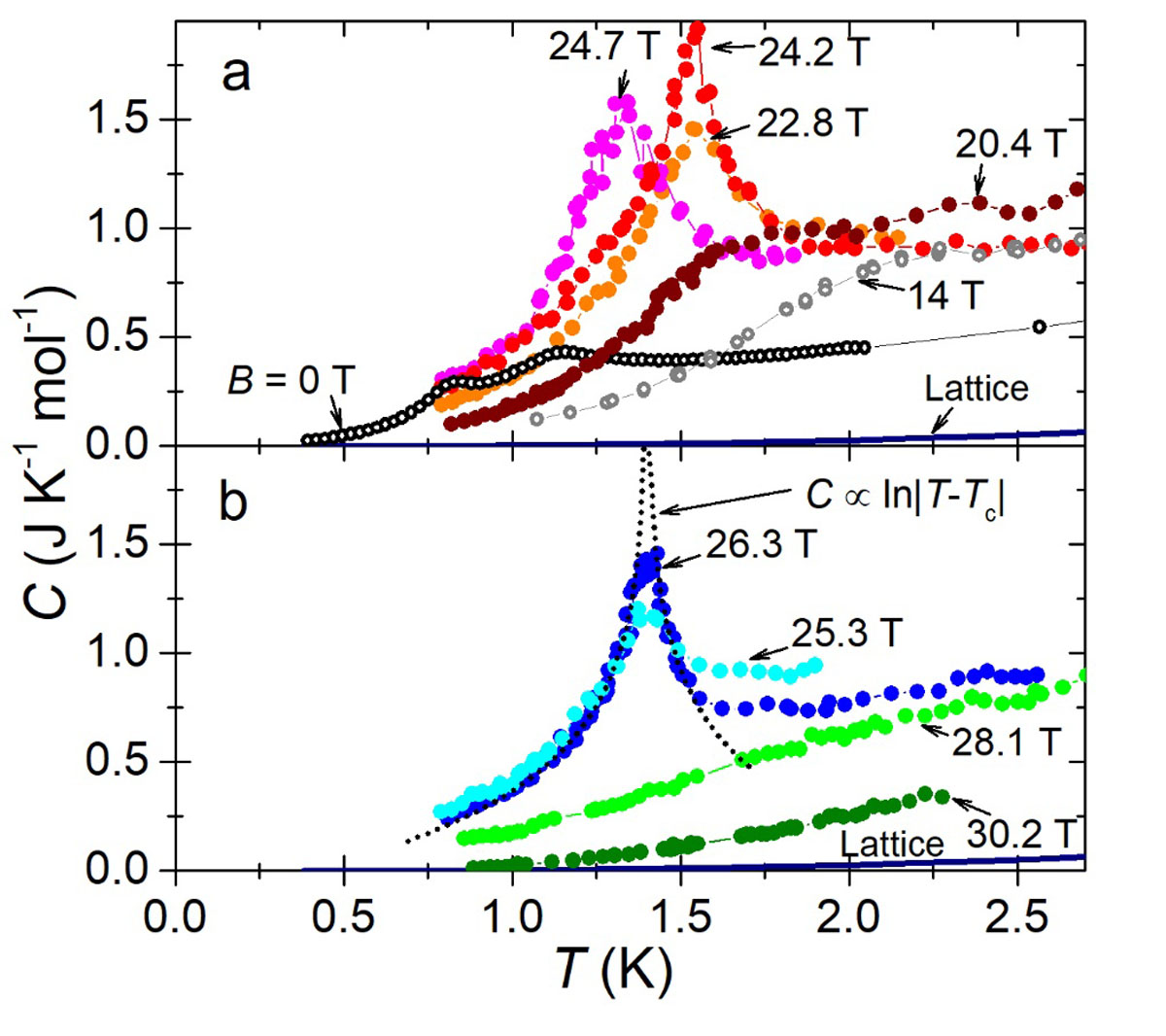Observation of Quantum Spin-Nematic Phase in Volborthite
Kohama, Kindo and Hiroi Groups
For a long time, it was believed that matter could exist in only three different forms, solid, liquid and gas. However, in the second half of the nineteenth century, it became clear that not all substances could be described as solid, liquid or gas. Liquid crystals came of age in the twentieth century, as both a subject of fundamental research and the basis for modern display technology. Since we know examples of quantum gases, liquids and solids, it is natural to ask, are there quantum liquid crystals, too? For a long time, this question remained a mathematical curiosity. However, in recent years, potential quantum analogues of a liquid crystal state have been discussed in real material, which is called a quantum spin-nematic state. Its experimental observation has proved much more challenging, since the order parameter of the spin nematic state, spin quadrupole moment, is hard to detect with conventional magnetic probes.
In this research, with an exotic frustrated magnet, volborthite, we provided the possible evidence of quantum analogue of the nematic crystal, and resolved a long-standing mystery about the magnetism of volborthite [1]. Here we applied thermodynamic measurement techniques, the magnetocaloric effect (MCE) and specific heat(C) measurements, which measure entropy and sensitive to any phase transition irrespective of the type of the order parameter. The state-of-art experimental capability in IMGSL; high-field calorimetry in magnetic fields up to 60 T and low temperatures down to 0.5 K, enabled observation of quantum spin-nematic state in volborthite.
First, we show the MCE curves obtained in the adiabatic condition, T(H), in Fig. 1(a). The adiabat T(H) initially decreases with increasing fields, before passing a broad minimum at ~25 T and then increases at higher fields. Below 1.7 K, a notable change occurs as seen in the enlarged plot (Fig. 1(b)). The broad minimum in T(H) acquires small dips, indicative of phase transitions at 22.5, 25.5 and 27.5 T. Each of these three critical fields has also been found in measurements of MCE under nearly isothermal conditions as shown in Fig. 1(b) as black and green curves. In Fig. 1(b), we also plot the phase boundary deduced from MCE and C(T) measurements.
We have further investigated the temperature-dependence of C in magnetic fields up to 30.2 T as seen in Fig. 2. In the absence of magnetic field, C(T) exhibits small peaks as reported previously (See Fig. 2(a)). The onset of SDW order (Phase II) is also revealed as a broad shoulder in C(T). Different behavior is observed above 22.5T where the transition is marked by a substantial λ-shaped anomaly. An extremely sharp peak (Fig. 2(b)) is developed above 25.5 T, consistent with the phase boundary identified in MCE. Above the crossover field to the plateau state (P) at 27.5T, no anomaly is observed in C(T). These observations provide unequivocal evidence that there are two different magnetic states between SDW and plateau states, i.e., Phases N1 and N2 as seen in Fig. 1(b). It is important to note that the earlier NMR results [2], however, failed to resolve the phase N2. Since the spin quadrupole moment cannot be detected by conventional magnetic probes such as NMR, it is reasonable to consider the phase N2 between 25.5 and 27.5 T is the ordered state of the quadruple moment that is so-called a quantum spin nematic state.
References
- [1] Y. Kohama, H. Ishikawa, A. Matsuo, K. Kindo, N. Shannon, and Z. Hiroi, PNAS 116(22) 10686 (2019).
- [2] H. Ishikawa, M. Yoshida, K. Nawa, M. Jeong, S. Kramer, M. Horvatic, C. Berthier, . Takigawa, M. Akaki, A. Miyake, M. Tokunaga, K. Kindo, J. Yamaura, Y. Okamoto, and Z. Hiroi, Phys. Rev. Lett. 114, 227202 (2015).
- [3] O. Janson, S. Furukawa, T. Momoi, P. Sindzingre, J. Richter, and K. Held, Phys. Rev. Lett. 117, 037206 (2016).


